 Global| Dec 17 2009
Global| Dec 17 2009U.S. Initial JoblessInsurance Claims Unexpectedly Rise To Highest In One Month
by:Tom Moeller
|in:Economy in Brief
Summary
Recent steadying in the job market stalled last week. The Labor Department indicated that initial claims for unemployment insurance rose to 480,000 from a little-revised 473,000 during the prior week. As a result, claims reached the [...]
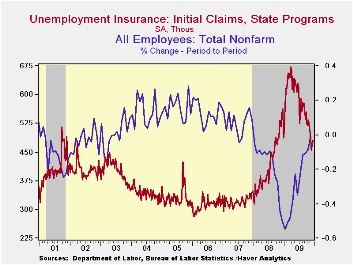 Recent
steadying in the job market stalled last week. The Labor Department
indicated that initial claims for unemployment insurance rose to
480,000 from a little-revised 473,000 during the prior week. As a
result, claims reached the highest level in four weeks but remained
down from the recession peak of 674,000 hit in March. The four-week
moving average of claims slipped to 467,500 and the latest weekly
figure was higher than Consensus expectations for a decline to 465,000
claims.
Recent
steadying in the job market stalled last week. The Labor Department
indicated that initial claims for unemployment insurance rose to
480,000 from a little-revised 473,000 during the prior week. As a
result, claims reached the highest level in four weeks but remained
down from the recession peak of 674,000 hit in March. The four-week
moving average of claims slipped to 467,500 and the latest weekly
figure was higher than Consensus expectations for a decline to 465,000
claims.
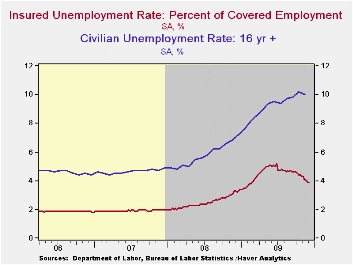 Initial
claims during the latest week cover the survey period
for November nonfarm payrolls. Claims fell 21,000 (4.2%) from the same
week in October. During the last ten years there has been a negative
84% correlation between the level of claims and the m/m change in
nonfarm payrolls.· Continuing claims for unemployment insurance during
the latest week ticked up 5,000 after a little-revised 289,000 decline
during the week prior. Continuing claims were at the lowest level since
late-February. The overall decline is a function of the improved job
market but also reflects the exhaustion of unemployment benefits.
Continuing claims provide an indication of workers' ability to find
employment. The four-week average of continuing claims fell to
5,318,250. This series dates back to 1966.
Initial
claims during the latest week cover the survey period
for November nonfarm payrolls. Claims fell 21,000 (4.2%) from the same
week in October. During the last ten years there has been a negative
84% correlation between the level of claims and the m/m change in
nonfarm payrolls.· Continuing claims for unemployment insurance during
the latest week ticked up 5,000 after a little-revised 289,000 decline
during the week prior. Continuing claims were at the lowest level since
late-February. The overall decline is a function of the improved job
market but also reflects the exhaustion of unemployment benefits.
Continuing claims provide an indication of workers' ability to find
employment. The four-week average of continuing claims fell to
5,318,250. This series dates back to 1966.
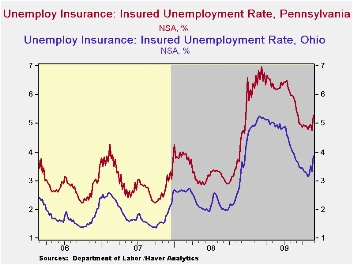 Extended
benefits for unemployment insurance retraced much of the prior week's
decline with a rise to 503,100 during the fourth week of November. The
latest compares to 550,343 during all of October.
Extended
benefits for unemployment insurance retraced much of the prior week's
decline with a rise to 503,100 during the fourth week of November. The
latest compares to 550,343 during all of October.
The insured rate of unemployment remained stable at 3.9%, the lowest level since February. The rate reached a high of 5.2% during late-June. During the last ten years, there has been a 93% correlation between the level of the insured unemployment rate and the overall rate of unemployment published by the Bureau of Labor Statistics. · The highest insured unemployment rates in the week ending November 28 were in Wisconsin (6.4), Oregon (6.3), Alaska (6.2), Nevada (5.5), Puerto Rico (5.5%), Pennsylvania (5.3), Michigan (5.3), California (4.9) and South Carolina (4.8). The lowest insured unemployment rates were in North Dakota (1.6%), Virginia (2.2), Texas (2.6), Maine (3.1), Wyoming (3.2), Maryland (3.2), Mississippi (3.7), New York (3.8), Florida (3.8) and Ohio (3.9). The data are not seasonally adjusted but the overall insured unemployment rate is.· The unemployment insurance claims data is available in Haver's WEEKLY database and the state data is in the REGIONW database.
| Unemployment Insurance (000s) | 12/12/09 | 12/05/09 | 11/28/09 | Y/Y | 2008 | 2007 | 2006 |
|---|---|---|---|---|---|---|---|
| Initial Claims | 480 | 473 | 454 | -13.0% | 420 | 321 | 313 |
| Continuing Claims | -- | 5,186 | 5,181 | 19.1% | 3,342 | 2,552 | 2,459 |
| Insured Unemployment Rate (%) | -- | 3.9 | 3.9 | 3.3 (12/2008) | 2.5 | 1.9 | 1.9 |
by Tom Moeller December 17, 2009
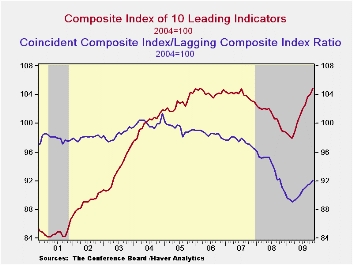
The Conference Board's Index of Leading Economic Indicators continued its uptrend last month giving a strong signal that the recent recession has ended. The 0.9% rise during November was the eighth consecutive monthly increase. Moreover, the 10.2% (centered) rate of increase during the last six months was nearly the strongest since early-1983. The leading index is based on actual reports for eight economic data series. The Conference Board initially estimates two series, consumer and capital goods orders.
The breadth of increase amongst the component series sagged
again last month. Sixty-five percent of the components rose during
November versus last month's reading of 70% that increased. During the
most recent six months, however, 80% of the series rose. Prominent in
last month's increase was a longer workweek, fewer jobless insurance
claims, more building permits, and the steeper interest rate yield
curve. These gains were offset by easier vendor performance, lower
consumer expectations and a downtick in capital goods orders.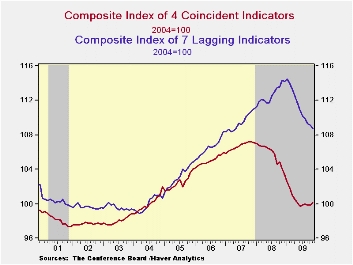
Continuing to suggest that the rate of decline in the economy is slowing were the coincident indicators which rose for the first month in the last three. The 0.2% gain followed an unrevised no-change during October. During the last six months the 1.4% rate of decline in the coincident series compares with a shortfall of 8.0% at its worst in January. Moderation of earlier declines has been due to higher industrial production, higher real personal income and higher business sales as well as easier declines in payroll employment.
In a continued sign that excesses in the U.S. economy are falling, the lagging index has been falling since January. Leading the decline has been lower commercial & industrial loans outstanding as well as slower growth in labor costs and less consumer credit. The ratio of coincident-to-lagging indicators (another leading indicator) also continued higher for the eighth straight month to the highest level since November.
The Conference Board figures are available in Haver's BCI database. Visit the Conference Board's site for coverage of leading indicator series from around the world.
| Business Cycle Indicators (%) | November | October | September | August 6-Month % (AR) | 2008 | 2007 | 2006 |
|---|---|---|---|---|---|---|---|
| Leading | 0.9 | 0.3 | 1.2 | 10.2 | -2.8 | -0.3 | 1.5 |
| Coincident | 0.2 | 0.0 | -0.1 | -1.4 | -0.9 | 1.6 | 2.5 |
| Lagging | -0.4 | -0.2 | -0.5 | -6.3 | 2.9 | 2.8 | 3.3 |
Philadelphia Fed Index Gains With Strength in Employment
by Tom Moeller December 17, 2009
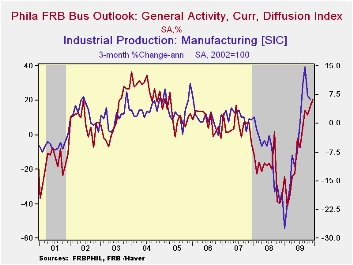 The
Philadelphia Federal Reserve Bank indicated that its index of regional
factory sector activity rose this month to its highest level since
early-2005. At 20.5, the index was unexpectedly strong and positive for
the fifth consecutive month. The latest level compared to figures near
-40.0 this past fall and winter.
The
Philadelphia Federal Reserve Bank indicated that its index of regional
factory sector activity rose this month to its highest level since
early-2005. At 20.5, the index was unexpectedly strong and positive for
the fifth consecutive month. The latest level compared to figures near
-40.0 this past fall and winter.
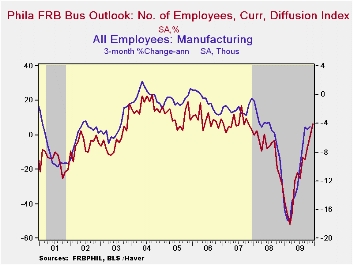 During the
last ten years there has
been a 77% correlation between the level of the Philadelphia Fed
Business Conditions Index and the three-month growth in factory sector
industrial production. There has been a 70% correlation with q/q growth
in real GDP. The latest survey from the Philadelphia Federal Reserve
Bank can be found here.·
Amongst the components, the employment index was notably strong as it
rose to well above break-even and to the highest level since late-2007.
During the last ten years there has been a 91% correlation between the
index level and the three-month change in manufacturing sector
payrolls. Remaining strong were shipments, the workweek, unfilled
orders and the delivery times components. The inventory component also
improved significantly from its March low.
During the
last ten years there has
been a 77% correlation between the level of the Philadelphia Fed
Business Conditions Index and the three-month growth in factory sector
industrial production. There has been a 70% correlation with q/q growth
in real GDP. The latest survey from the Philadelphia Federal Reserve
Bank can be found here.·
Amongst the components, the employment index was notably strong as it
rose to well above break-even and to the highest level since late-2007.
During the last ten years there has been a 91% correlation between the
index level and the three-month change in manufacturing sector
payrolls. Remaining strong were shipments, the workweek, unfilled
orders and the delivery times components. The inventory component also
improved significantly from its March low.
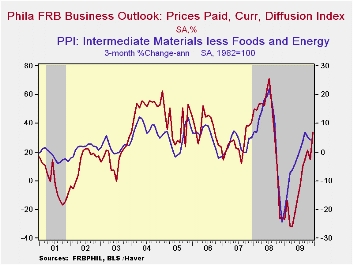 The prices paid index rose
sharply to its highest level since August of last year and compares to
negative readings this past winter and spring. During the last ten
years there has been a 71% correlation between the prices paid index
and the three-month growth in the intermediate goods PPI. There has
been an 82% correlation with the change in core intermediate goods
prices.
The prices paid index rose
sharply to its highest level since August of last year and compares to
negative readings this past winter and spring. During the last ten
years there has been a 71% correlation between the prices paid index
and the three-month growth in the intermediate goods PPI. There has
been an 82% correlation with the change in core intermediate goods
prices.
Expected business conditions in six months deteriorated for the sixth straight month. The December index fell to a still-positive reading of 24.4 but that was well-off the recent high. Many of the index components, especially orders and shipments, were down sharply.· The figures from the Philadelphia Federal Reserve can be found in Haver's SURVEYS database.
| Philadelphia Fed (%) | December | November | October | December '08 | 2009 | 2008 | 2007 |
|---|---|---|---|---|---|---|---|
| General Activity Index | 20.4 | 16.7 | 11.5 | -35.1 | -7.5 | -21.3 | 5.0 |
| New Orders | 6.5 | 14.8 | 6.2 | -29.3 | -9.6 | -14.7 | 6.9 |
| Number of Employees | 6.3 | -0.5 | -6.8 | -23.8 | -23.7 | -8.7 | 6.8 |
| Prices Paid Index | 33.8 | 14.9 | 21.3 | -26.6 | -4.0 | 36.4 | 26.3 |
UK Retail Sales Take A Sett Back In November But Cling To Trend Rise
by Robert Brusca December 17, 2009
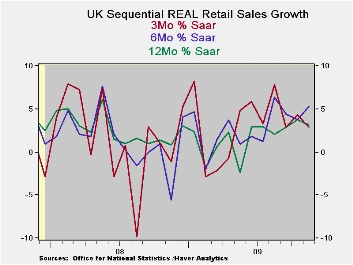
UK retail sales volumes fell by 0.3% in November after having
rise in October. Sales volumes have risen twice in the last
three-months and seven times in the last 12-months.
The three-month rate of growth has dipped below the six-month
rate of growth but still exceeds the 12-month growth pace. Clothing and
footwear sales, however, are clearly losing momentum having dropped in
the last three months. Retail ex-auto sales are off from their six
month pace but nearly even with their 12-month pace.
In the new quarter, Sales are growing at a pace of 3% to 3.5%.
That should help to underpin Q4 GDP growth.
In a separate report, the CBI survey of the distributive
trades produced diffusion results saying that November sales were flat
with those in October. That of course is more ambitious that the sales
count from National Statistics (above). The outlook in the CBI
framework was negative, however.
A poll of UK inflation expectations found that expectations
were stuck at 2.4% for the third consecutive quarter. While this is
above the BOE ceiling pace for inflation (of 2%) the Bank has admitted
that there would be some temporary overshoot to which it will not
respond. It is heartening that as inflation has risen in the UK,
inflation expectations have not. BOE credibility seems to be well
intact despite the damage done in the financial crisis.
| UK Real and Nominal Retail Sales | Quarter | |||||||
|---|---|---|---|---|---|---|---|---|
| Nominal | Nov-09 | Oct-09 | Sep-09 | 3-MO | 6-MO | 12-MO | YrAGo | 2-date |
| Retail Total | -0.3% | 0.5% | 0.4% | 2.9% | 4.0% | 2.6% | 2.0% | 3.2% |
| Food Bev & Tobacco | 0.2% | 0.2% | 0.1% | 2.3% | 2.2% | 3.4% | 7.3% | 2.5% |
| Clothing footwear | -2.0% | 1.5% | 0.4% | -0.7% | 1.5% | 1.4% | -1.7% | 0.3% |
| Real | ||||||||
| Retial Ex auto | -0.4% | 0.6% | 0.4% | 2.9% | 5.3% | 3.1% | 0.8% | 3.6% |
Tom Moeller
AuthorMore in Author Profile »Prior to joining Haver Analytics in 2000, Mr. Moeller worked as the Economist at Chancellor Capital Management from 1985 to 1999. There, he developed comprehensive economic forecasts and interpreted economic data for equity and fixed income portfolio managers. Also at Chancellor, Mr. Moeller worked as an equity analyst and was responsible for researching and rating companies in the economically sensitive automobile and housing industries for investment in Chancellor’s equity portfolio. Prior to joining Chancellor, Mr. Moeller was an Economist at Citibank from 1979 to 1984. He also analyzed pricing behavior in the metals industry for the Council on Wage and Price Stability in Washington, D.C. In 1999, Mr. Moeller received the award for most accurate forecast from the Forecasters' Club of New York. From 1990 to 1992 he was President of the New York Association for Business Economists. Mr. Moeller earned an M.B.A. in Finance from Fordham University, where he graduated in 1987. He holds a Bachelor of Arts in Economics from George Washington University.






